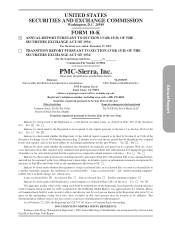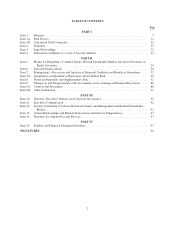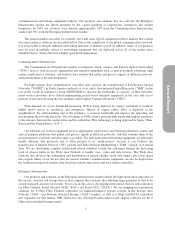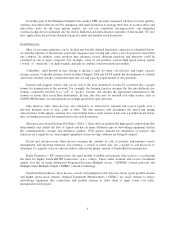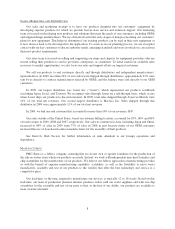Adaptec 2009 Annual Report Download - page 6
Download and view the complete annual report
Please find page 6 of the 2009 Adaptec annual report below. You can navigate through the pages in the report by either clicking on the pages listed below, or by using the keyword search tool below to find specific information within the annual report.
In another part of the Enterprise Infrastructure market, PMC provides integrated solutions for laser printers,
switches and routers that are used by enterprises and small businesses to manage their data on an inter-office and
intra-office basis. In the laser printer market, we sell our standalone microprocessors and integrated
system-on-chip devices primarily into the mid-to high-end and multi-function segments of that market. We also
have applications for network-attached storage for small and medium sized businesses.
O
UR
P
RODUCTS
Most of our semiconductors can be divided into broadly defined functional categories as identified below.
As with descriptions of the network, particular categories may overlap and a device may be present in more than
one category. In addition, some products may integrate several different functions and therefore could be
classified in one or more categories. For example, some of our products convert high-speed analog signals
(“wired” or “wirelessly”) to digital signals and split or combine various transmission signals.
Controllers: rapid growth in data storage is driving a need for more cost-effective and larger capacity
storage systems. Controller products based on Fibre Channel, SAS and SATA enable the development of external
and server-attached storage systems that meet the cost and capacity requirements of our customers.
Framers and mappers: before data can be sent to the next destination, it must be converted into a proper
format for transmission in the network. For example, the framing function arranges the bits into different size
formats, commonly referred to as “cell” or “packet” formats, and attaches the appropriate information to the
formats to ensure they reach their destinations. In turn, this data may be inserted into other frames, such as
SONET/SDH frames, for transmission across high-speed fibre optic networks.
Line interface units: these devices, also referred to as transceivers, transmit and receive signals over a
physical medium such as wire, cable or fibre. The line interface unit determines the speed and timing
characteristics of the signals, and may also convert them from a serial stream of data into a parallel stream before
they are further processed for transmission to the next destination.
Microprocessor-based System-On-Chips (“SOCs”): these devices perform the high-speed computations that
help identify and control the flow of signals and data in many different types of networking equipment used in
the communications, storage and enterprise markets. With greater demand for integration of features and
functions on a single device, more highly-integrated system-on-chip solutions are being developed.
Packet and cell processors: these devices examine the contents of cells, or packets, and perform various
management and reporting functions. For instance, a switch or router may use a packet or cell processor to
determine if a signal is voice or video in order to allocate the proper amount of bandwidth for transmission.
Radio Frequency (“RF”) transceivers: the rapid growth of mobile and nomadic data services is accelerating
the need for higher bandwidth RF transceivers (a.k.a. radios). These radios transmit and receive broadband
signals over the air using Orthogonal Frequency-Division Multiple Access (“OFDMA”) based protocols and
Multiple-Input-Multiple-Output (“MIMO”) antenna technology.
Serializers/Deserializers: these devices convert and multiplex traffic between slower speed parallel streams
and higher speed serial streams. Original Equipment Manufacturers (“OEMs”) use serial streams to reduce
networking equipment line connections and parallel streams to allow them to apply lower cost traffic
management technologies.
6

